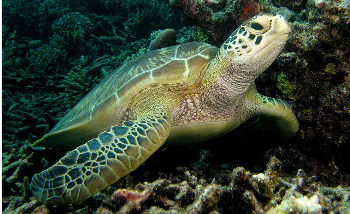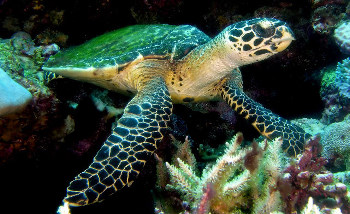 |
 |
So what’s the difference between a Hawksbill Turtle and a Green Turtle? |
Taxonomy
The Green turtle (Chelonia mydas) and Hawksbill turtle (Eretmochelys imbricata) both belong to the family Cheloniidae. They are both the only species in their respective genus.
|
Distribution
The Hawksbill has a worldwide distribution, with Atlantic and Pacific subspecies and the Green turtle can be found throughout tropical and subtropical seas around the world, with two distinct populations in the Atlantic and Pacific Oceans. |
Morphology
The Green and Hawksbill turtles look very similar to each other however they have some differences in appearance. The Hawksbill can be distinguished from the Green Turtle by its sharp, curving beak with prominent cutting edge, and the saw-like appearance of its shell margins.
The Green Turtle is the most typical sea turtle, possessing a teardrop-shaped carapace and a pair of large, paddle-like flippers. Despite the turtle's common name, it is lightly-coloured all around while its carapace's hues range from olive-brown to black in Eastern Pacific green turtles. The turtle is actually named for the greenish coloration of its fat and flesh.
|
Diet
Unlike other members of the turtle family, the Green turtle is mostly herbivorous. The adults are commonly found in shallow lagoons, feeding mostly on various species of seagrass. Sponges are the principal diet of hawksbills once they enter shallow coastal waters and begin feeding on the bottom. Some of the sponges eaten by Hawksbills are known to be highly toxic and lethal when eaten by other organisms. Hawksbills are also known to feed on other invertebrates, such as comb jellies and jellyfish. |
Size
The largest Green turtle ever recorded weighed 395 kilograms whilst the Hawksbills are generally smaller with the largest recorded tipping the scales at 127 kilograms. |
Conservation
There are 7 species of turtles found worldwide and they are all considered to be threatened. The main threats are pollution and changes to important turtle habitats, such as coral reefs, seagrass beds, mangrove forests and nesting beaches. Other threats include accidental drowning in fishing gear, over-harvesting of turtles and eggs, and predation of eggs and hatchlings by other animals. |